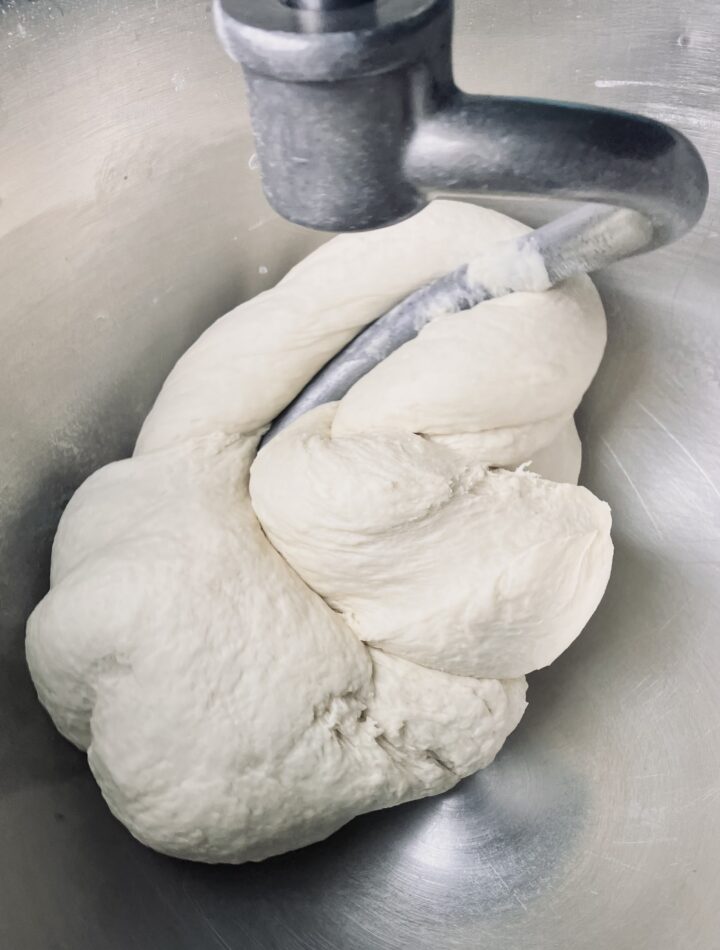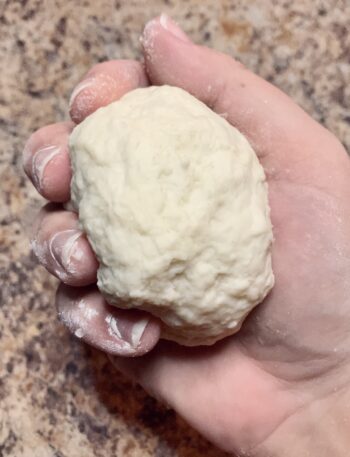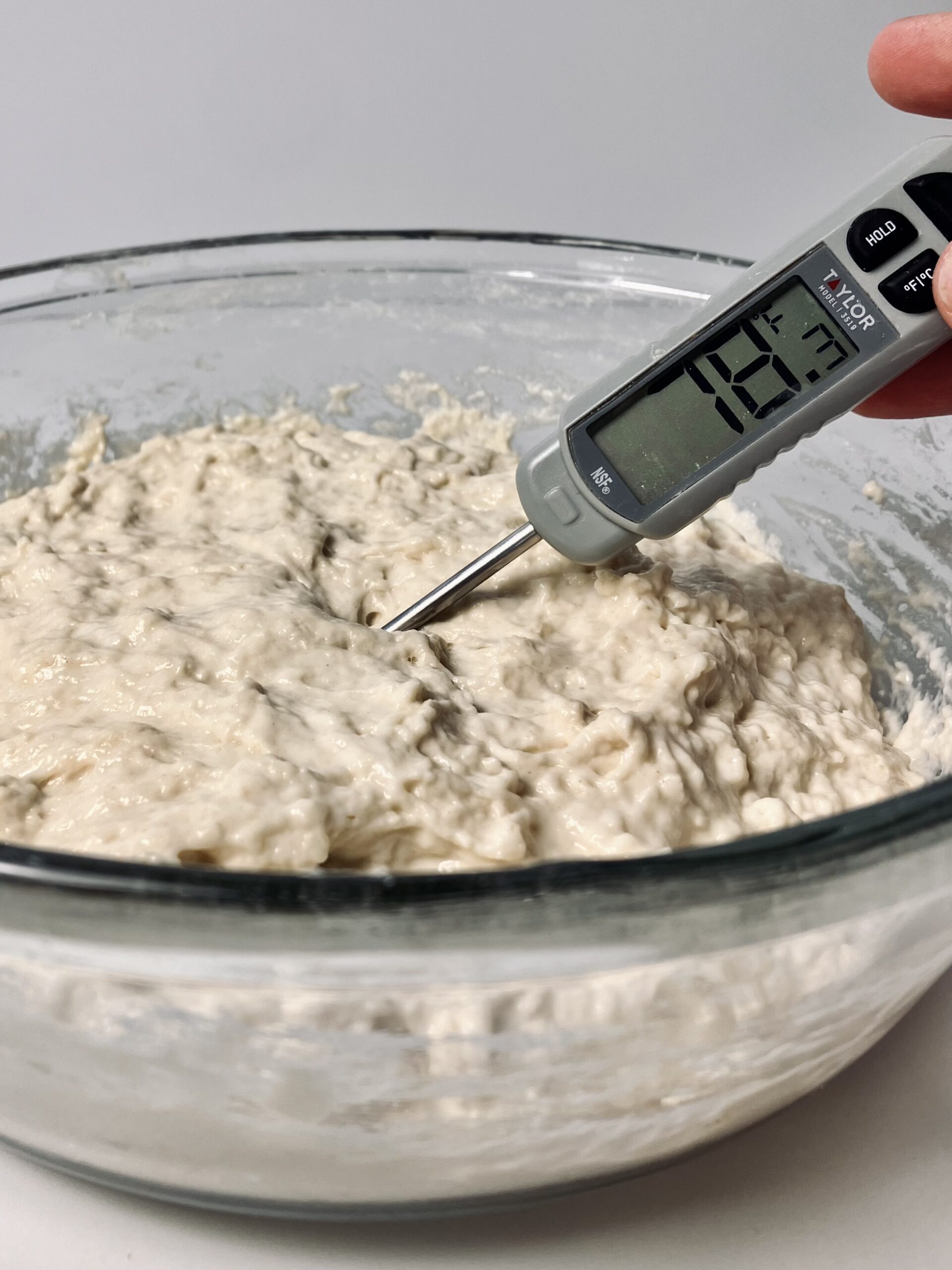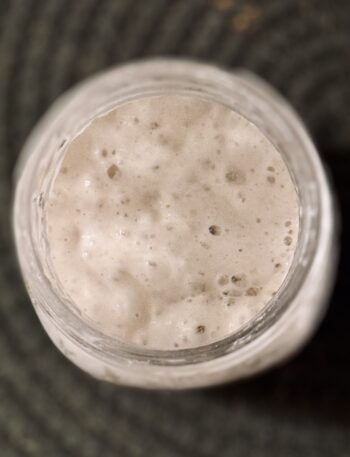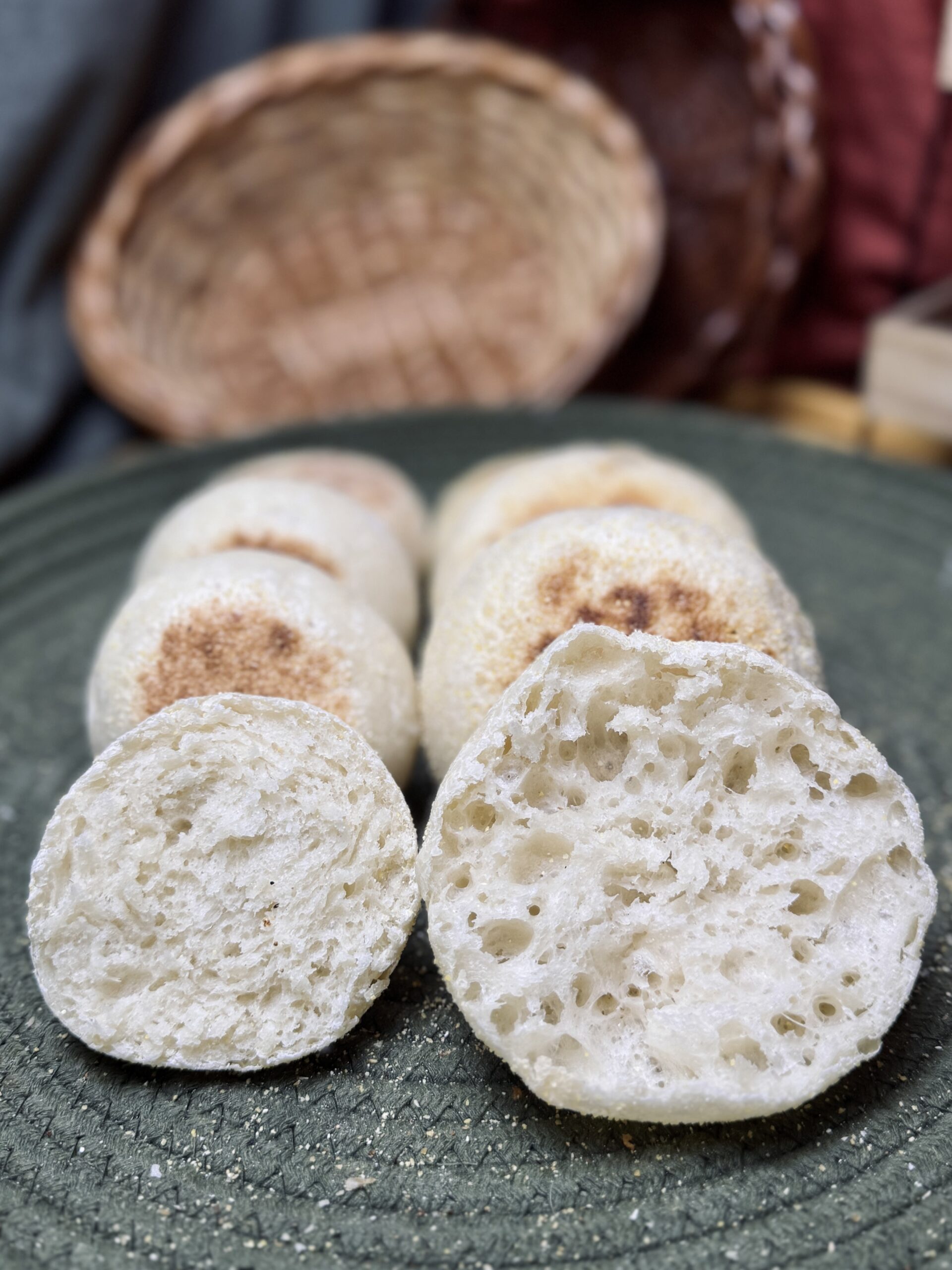When baker’s reference hydration, they are talking about how wet or dry their dough is. Hydration simply means water. Mathematically, the term “hydration” is used to express the proportion of water relative to flour in a bread recipe via a percentage. But, hydration can look and feel different with every type of dough. That’s because every ingredient, and even every type of flour, absorbs water differently. Knowing how to understand and adjust your dough’s hydration to get the effects you are going for in your bread is a key skill for bakers seeking to master the art and science of bread-making.
What Is Hydration?
Hydration refers to the ratio of water to flour in a bread recipe, which is expressed as a percentage. Specific percentages are generally classified as “low,” “moderate,” or “high” hydration: each classification significantly influencing the texture, structure, and final outcome of the baked product.
Hydration is calculated by dividing the weight of the water in the recipe by the weight of the flour, then multiplying by 100 to express it as a percentage.
The formula is: Hydration % = (Weight of Water/Weight of Flour) × 100

Why Should I Care About Hydration?
Hydration has an effect on every aspect of the bread-making process – from the way the dough must be handled to the texture it produces in your bread. Though it’s not essential to understand hydration to make great bread, knowledge of its effects can improve the quality and consistency of your loaves. Hydration affects –
- Texture, Crust, and Crumb: Higher hydration breads generally result in a more open and irregular crumb with a lighter, thinner crust and a chewier, artisanal texture. On the other hand, lower hydration breads tend to result in a tighter crumb structure, with a (potentially) thicker crust (depending on the style/how the bread is baked) and a softer texture.
- Handling and Workability: High hydration doughs can be more difficult to work with because the dough is looser and stickier. Meanwhile, lower hydration doughs tend to be easier to work with because they are firmer and softer (but not sticky), making them more manageable.
- Fermentation and Flavor Development: High hydration doughs are preferable for the bacteria in your starter, which produce acids that can lead to more complex, and often desirable, flavors in bread. Conversely, lower hydration doughs favor yeast growth over bacterial growth, which generally contributes to a milder flavor profile in bread.
- Flour Types and Varieties: Different types of flour absorb water differently. Some are capable of absorbing a lot of water, while others are not. This means that different hydrations paired with different flours result in different consistencies in bread dough. Hydration awareness allows for flexibility in adapting recipes to different flours.
- Consistency and Reproducibility: Knowing what hydration works with each recipe you bake and flour you use creates predictability and repeatable, reliable baking outcomes.
A General Classification Of Hydration
Low Hydration (Below 65%)
Low hydration doughs, in regards to white wheat flour, are firm and soft to the touch. Because they hold together so well, they are great for beginners or for making complex shapes (such as pretzels). These doughs generally produce a softer, denser crumb.
Moderate Hydration (65-80%)
This range is common for a variety of bread types. It allows for a good balance between workability and the development of gluten structure. These doughs are stickier, but still manageable, and produce a lighter, airier crumb than their low hydration counterparts.
High Hydration (Above 80%)
Doughs with higher hydration levels, in regards to white wheat flour, are the most difficult to work with because they are looser and stickier than other hydrations. In addition, gluten does not come together as easily, which shapes/differentiates the bread-making process from other hydrations. These doughs are characteristic of artisanal and rustic breads, producing a more open crumb structure and a chewier end result when handled correctly.
Low Hydration Doughs (Below 65%)
Low hydration doughs are characterized by their low water to flour ratio, which is generally less than 65% (using the formula provided above). These doughs tend to be firmer, less sticky, and easier to handle compared to their higher hydration counterparts. They are perfect for making fun and versatile shapes, such as braids, are simple and quick to throw together/develop, and are more flexible when it comes to proofing. In my opinion, low hydration doughs are great for beginners due to their flexibility and ease of handling.
Characteristics Of Low Hydration Doughs
Firmness
Low hydration doughs are firmer and less extensible (stretchy). The gluten network is less hydrated, resulting in a dough that is easier to shape and mold.
Easier Handling
These doughs are generally soft, but not sticky, making them more manageable during shaping and forming. Bakers have more control over the dough, which can be advantageous for creating specific shapes, such as braids and twists.
Uniform Crumb
Low hydration doughs often produce a more uniform crumb structure with smaller and more evenly distributed air pockets. This can result in a softer, denser texture in the final baked product.
Examples Of Low Hydration Doughs
Gluten In Low Hydration Doughs
Stiff, low hydration doughs are also typically considered “high gluten” doughs. While these doughs easily come together and hold their shape, the lack of water also makes it harder for gluten to form. Without enough gluten-binding proteins, the dough may struggle to form a gluten window, which allows opportunity for air to escape. This decreases the dough’s ability to rise to its fullest potential, resulting in a denser crumb and texture. Gluten must be developed through kneading and time; the more help it can get the better. Using a flour with a high protein content can be helpful.
Fermenting Low Hydration Doughs
Breads with lower hydration typically have a more flexible fermenting schedule, due to the increased amount of flour (which is food for the starter). In order for bread dough to “overproof”, one of two things will happen: a) the bacteria in your starter have broken down the gluten network, which results in the dough losing air and structure, or b) the yeast have “popped” the balloon (gluten network) with which they were blowing up because it either was not developed enough or fermented for too long. This means that, when developed correctly, low hydration doughs can triple or quadruple in size before they overproof, though it can still happen. It is not necessary to ferment a low hydration dough to its maximum point for excellent results in the recipe, in fact, sometimes it is undesired (depending on the outcome you’re going for). The extra flour brings a softer, more tender texture to the bread once baked. However, it is good to keep in mind that going a little bit over what the recipe calls for on fermentation will not be the end-all for your bread.
Shaping Low Hydration Doughs
Low hydration doughs are the easiest to shape for the same reason they have a more flexible fermenting schedule: increased flour. This makes them firm and soft. They typically do not require an extra sprinkling of flour on the counter to keep them from sticking, as they are generally minimally sticky or not sticky at all. They can be easily divided and maneuvered to the baker’s intent.
Moderate Hydration Doughs (65-80%)
Moderate hydration doughs offer a balanced compromise between the ease of handling seen in low hydration doughs and the extensibility and open crumb structure of high hydration doughs, generally falling in the range of 65-80% hydration (using the formula provided above). These doughs are looser, yet still manageable, yielding a lighter, airier crumb than their low hydration counterparts.
Characteristics Of Moderate Hydration Doughs
Perfectly Balanced
Moderate hydration doughs strike a balance between firmness and extensibility (the dough’s ability to stretch). The gluten network is adequately hydrated (not under or over), resulting in a dough that is both workable and capable of producing a variety of bread styles and textures.
Versatility
These doughs are incredibly versatile and can be used for a wide range of bread types, from sandwiches, to sweet breads, to, artisanal/crusty breads with some open crumb structure.
Reasonable Handling
While slightly stickier than low hydration doughs, moderate hydration doughs are still reasonable to handle, and are manageable during shaping and forming.
Examples Of Moderate Hydration Doughs
Gluten In Moderate Hydration Doughs
Because moderate hydration doughs are adequately hydrated (they are neither under- or over-hydrated), gluten develops well on its own (over time) or through kneading (via stand mixer or by hand). This means that flours with varying protein levels can be used with great results (noting that technique will need to be adjusted depending on the characteristics of the flour). Strong flours (flours with a high protein content) can handle more water and less gluten development (folds or kneading), while weaker flours need less water and more gluten development.
Fermenting Moderate Hydration Doughs
Breads with moderate hydration are less flexible in their fermenting schedule than breads with low hydration, due to having less flour and more moisture than their low hydration counterparts. The yeast and bacteria in your starter are moisture-loving, and reproduce more quickly in wet environments, which can cause the dough to overproof faster. These doughs can still reach double in size, and sometimes more if the dough is developed well, the starter is balanced, and fermentation is pushed.
Shaping Moderate Hydration Doughs
Moderate hydration doughs are still manageable to shape, even though they are sticker than low hydration doughs. A little bit of flour, water, or oil can be used to help limit stickiness and make handling easier during different parts of the process. Because the dough is loose, the dough may lose its shape or form slightly if left to rest too long after shaping without some sort of aid, such as a banneton or loaf pan, to hold it accountable.
High Hydration Doughs (Above 80%)
High hydration doughs are characterized by their high water to flour ratio, which is generally above 80% (using the formula provided above). These doughs tend to be sticky and loose – the most difficult to handle of all the hydrations. They are known, and frequently sought after by bread enthusiasts, for creating bread with an open crumb. They produce the airiest dough with the thinnest crust and chewiest texture. Working with high hydration doughs requires specific techniques and considerations to handle the wet and slack nature of the dough while achieving the desired results.
Characteristics Of High Hydration Doughs
Difficult Handling
High hydration doughs are wetter, stickier, and looser than other dough hydrations, making them the most challenging to handle. Baker’s have less control over the dough and how it is formed, meaning most high hydration doughs are baked into loose shapes.
Open Crumb Structure
The increased water content makes the dough more extensible, which contributes to the development of larger and more irregular air pockets in the bread, resulting in a more open crumb when handled correctly. This is a current bread trend, and a characteristic that many bread enthusiasts seek at some point or another.
Chewy Texture
The higher hydration level means that flour has access to (and absorbs) more water, contributing to a chewier texture in the final baked product.
Examples Of High Hydration Doughs
Gluten In High Hydration Doughs
Gluten can be difficult to develop in high hydration doughs due to the excess water, which lends a more free-flowing network. If the flour is too weak (not enough gluten-binding proteins), it may not be able to absorb all of the water, or at least all of the water at one time, leading to a shaggy dough that tears and falls apart (one that doesn’t have a sufficient gluten structure). High hydration doughs can take a long time to develop, and often require special techniques like “double hydration” (when the water is added in two or three parts) or use of time + folds to help the dough come together. These doughs require a strong flour in order to form any kind of cohesive mass.
Fermenting High Hydration Doughs
High hydration breads have the most moisture of all, making their fermenting schedule much shorter – the least flexible of all the hydrations. This higher water to flour ratio is ideal for the yeast and bacteria in your starter, which are moisture-loving and reproduce most quickly in wet environments. Pair this with less flour, which means less food, as well as a more relaxed gluten structure (which is easier to break through), and these doughs are the most difficult to ferment. High hydration doughs can usually double in size at their maximum, but do not have to be pushed to this point.
Shaping High Hydration Doughs
High hydration doughs can be incredibly difficult to shape, as they are the stickiest and loosest of all the doughs. A heavy dusting of flour is typically used when shaping the dough, and they are usually shaped or cut with a bench scraper into simple squares (think ciabatta) or other loose shapes.
Hydration And Flour Choice
Different flours absorb water differently; therefore, the consistency of your dough will vary, depending on the type of flour used. Having knowledge of the flour being used and the hydration needed for best results can significantly impact the final bake.
For example, whole wheat and rye flours absorb a lot of water, meaning that even at 90% hydration they may feel similar to a moderate hydration dough. The dough likely wouldn’t be incredibly sticky or extensible, and the end result may not have an open crumb or be chewy in texture, despite the dough being classified as “high hydration,” due to its high water content.
Another example would be different levels of protein in white flours, whether using hard red spring wheat or soft white wheat. A white flour with a protein content of 14% is going to absorb a lot more water than a white flour with a protein content of 10%. This is the difference between bread flour, all-purpose flour, and cake flour; the protein content of the flour affects both how much water the flour can absorb, as well as how readily gluten will bring the dough together.
While different flours may affect the texture, feel, workability of the dough, and outcome of the bread, they do not affect hydration calculation. Any type of flour (milled grain product) can, and should, be included in hydration calculation. A bread made with 500 g of flour and 350 g of water still has a hydration of 70%, whether the flour used was all-purpose, bread, whole wheat, rye, spelt, or even gluten-free.
What Ingredients Besides Flour And Water Impact Hydration?
In regards to water: any liquid, such as milk, tea, coffee, juice, or alcohol (such as wine or beer) can be substituted as, or added to, the total amount of water when calculating hydration. While it is true that the quantities of solids and subcomponents (such as milk solids, tea or coffee granules, juice pulp, or alcohol) varies in each example, each contains enough water to count toward hydration.
Eggs contain around 75% water and can be counted toward hydration, if desired. The total amount of eggs by weight should be multiplied by .75 to determine the water content, and thereby impact on hydration.
Other ingredients that include varied water percentages include: butter (approximately 18% water content) and fresh fruit. While these will affect the overall hydration of the recipe, they are not necessary to included in hydration calculation.
In regards to dry ingredients: ingredients such as cocoa powder, dried fruit powders, and dry milk powder do not count toward hydration, even though they do absorb water and have varying impacts on the dough. Only milled grain products count toward hydration calculation.

How Do I Calculate The Hydration Of A Recipe?
There are two ways to calculate hydration: the simple way and the technical way. The simple way will suffice for approximating hydration, while the technical way will give the baker a more accurate representation of the hydration of a recipe.
To calculate hydration, use the formula: Hydration % = (Weight of Water/Weight of Flour) × 100
Let’s calculate the hydration of a simple, four ingredient bread recipe:
| 500 g bread flour |
| 350 g water |
| 100 g active sourdough starter |
| 10 g salt |
Simple Method
To calculate hydration the simple way, take the amount of water (350 g) and divide it by the amount of flour (500 g).
350 / 500 = .70
Now, multiply this by 100 to express hydration as a percentage.
.70 X 100 = 70
So, using the simple method of calculating hydration, this recipe has a hydration of approximately 70%.
Technical Method
When calculating hydration the technical way, it is essential to include all flour/water added to the recipe, including flour/water added from different ingredients. In the case of this four ingredient bread recipe, the starter must be included, since it consists of flour and water.
My sourdough starter is 100% hydration, meaning it is made up of equal parts flour and water. This means, in my case, 100 g of sourdough starter would be made up of 50 g flour + 50 g water.
This amount of flour and water needs to be added to the amounts in the recipe in order to calculate the actual hydration.
500 g bread flour + 50 g flour from the sourdough starter = 550 total grams of flour.
350 g water + 50 g water from the sourdough starter = 400 total grams of water.
Now, divide the total amount of water by the total amount of flour.
400 / 550 = .73
Last, multiply this number by 100 to express hydration as a percentage.
.73 X 100 = 73
So, using the technical method of calculating hydration, this recipe has an actual hydration of 73%.
How Do I Change The Hydration Of A Recipe?
Changing the hydration of a recipe is easy, requiring only simple math. To change the hydration, take the total amount of flour in the recipe and multiply it by the percent hydration you would like to change the recipe to. Let’s look at our previous example:
| 500 g bread flour |
| 350 g water |
| 100 g active sourdough starter |
| 10 g salt |
Simple Method
In the previous section, it was determined that the approximate hydration of this recipe was 70%. Let’s say we want it to be approximately 80%. Take the amount of flour in the recipe and multiply it by the percent hydration you would like to change the recipe to:
500 X .80 = 400
So, for this example, we would use 400 g of water (instead of 350 g) to make our recipe.
Technical Method
In the previous section, it was determined that the actual hydration of this recipe was 73%. Let’s say we want it to be 80%. Using this method, it is important to include water and flour found in the sourdough starter.
Total flour = 550 g (500 g bread flour + 50 g flour from the sourdough starter)
550 X .80 = 440
So, we need to have a total of 440 g of water in the recipe. Let’s not forget to subtract the amount of water from the sourdough starter:
440 – 50 = 390
So, for this example, we would add 390 g (instead of 350 g) of water to the dough for our recipe.
Conclusion
To sum, hydration simply means water. When baker’s reference hydration, they are expressing how much water they added to a dough in the form of a percentage. The consistency and texture of a dough will change with hydration, and will also vary depending on ingredients (including flours, liquids, and other flavoring ingredients) added to the dough.

